Part wild wild west adventure, part bohemian romance, there’s just something special about the feeling you get when visiting Joshua Tree National Park. There’s something at the park for everyone – towering rock formations and dusty trails for the rugged adventurer, easy family-friendly hikes and well-maintained campgrounds for those looking for more leisurely activities, otherworldly landscapes and artsy sites for the free thinkers, and wildly photogenic and colorful landscapes for photographers. Here’s the itinerary we followed when we spent 3 days in Joshua Tree National Park.
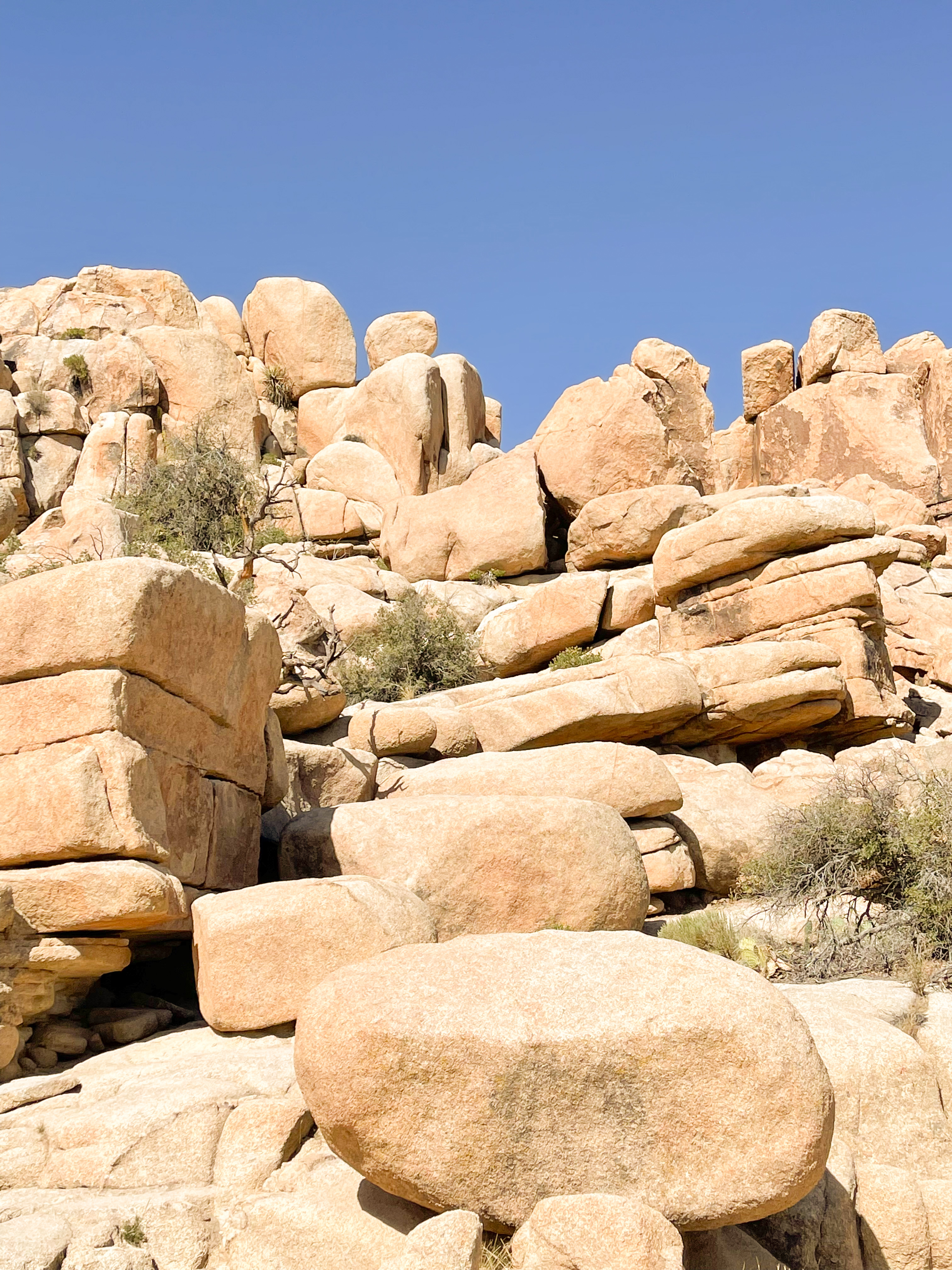
Where to Stay in Joshua Tree National Park
There are 3 different park entrance stations to Joshua Tree National Park: West entrance (nearest to Joshua Tree Village), North entrance (Twentynine Palms), and the South Entrance. If you’re coming from LA or Palm Springs like we did, you’ll likely enter from the West entrance. The North entrance is more conveniently located for folks driving from Las Vegas. The South entrance is most convenient for those coming from Phoenix or Santa Fe.
Related Post: Palm Springs Weekend Itinerary Inspiration
There’s no shortage of AMAZING lodging options at the park – from stylish renovated camper vans, to rugged campgrounds (both in and outside of the park), to quirky AirBnBs. We decided to book an AirBnB during our stay, specifically, a cabin located in the middle of the desert so that we could truly relax ‘off-the-grid’. Check out our exact AirbnB here. It was such a fun experience staying out in the middle of nowhere, even if it meant sacrificing the comforts of wi-fi, air conditioning, and well-paved roads for a few days. Our AirBnB was also situated between the North and West entrances, which was super convenient for spending 3 days in Joshua Tree National Park!

Other really cute options to check out include this fun and quirky 1964 airstream, this funky dome in the desert, or this modern bungalow.
When to Visit Joshua Tree National Park
Although the park is open year-round, the best time to visit Joshua Tree National Park is during shoulder season – either from March to May, or September to November. We visited in the month of May and the weather was absolutely perfect, the temperature was hot enough that we felt like we were still experiencing a nice sunny desert escape, but mild enough that we weren’t dying from overwhelming dry heat.
Joshua Tree National Park is composed of two deserts – the Mojave Desert as well as the Colorado Desert. These deserts have different elevations and ecosystems, thereforeo t’s important to note when traveling around Joshua Tree National Park that the daily temperatures can fluctuate widely! Pack layers – even though the daytime average while we were in Joshua Tree was around 90 degrees Fahrenheit, it definitely got to the low 60s at night.
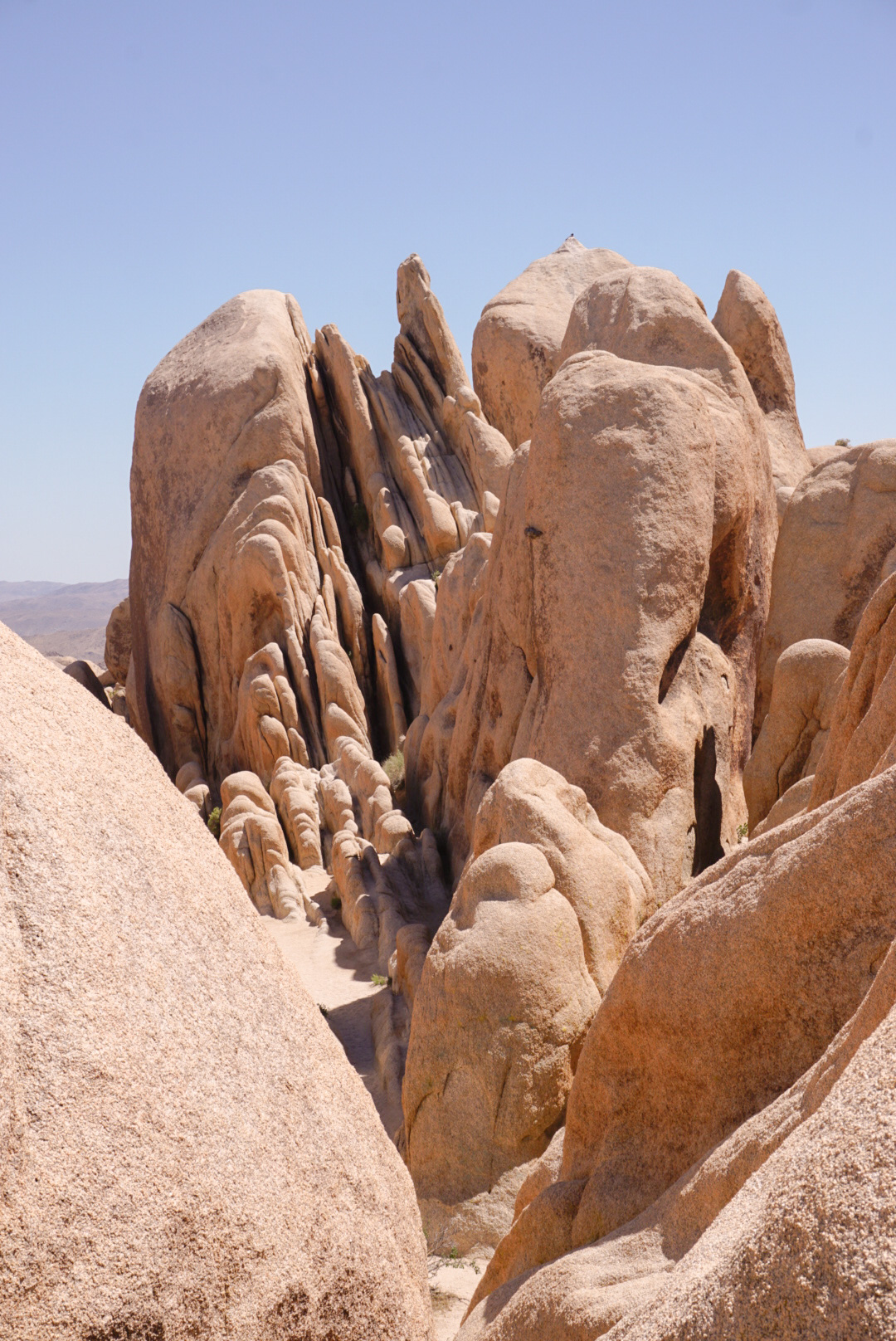
TIP: If you’re interested in seeing wildflowers during your visit to Joshua Tree, make sure to visit in the early spring months of March and April!
Related Post: Wallace Falls Hiking Trail near Seattle, Washington
Day 1 Itinerary: Twentynine Palms Area
Fortynine Palms Oasis Trail
Our Day 1 itinerary had us starting near the North entrance of Joshua Tree National Park. We kicked off the day with an early morning hike along the Fortynine Palms Oasis Trail. Note – this hike is near the North entrance but is still located outside of the national park gates so there is no fee to park and hike it. This moderate 3.1 mile roundtrip hike (~636 feet of elevation gain) is famous for sweeping panoramic views of the surrounding desert landscape, and it’s surprising end destination – a hidden oasis of palm trees!
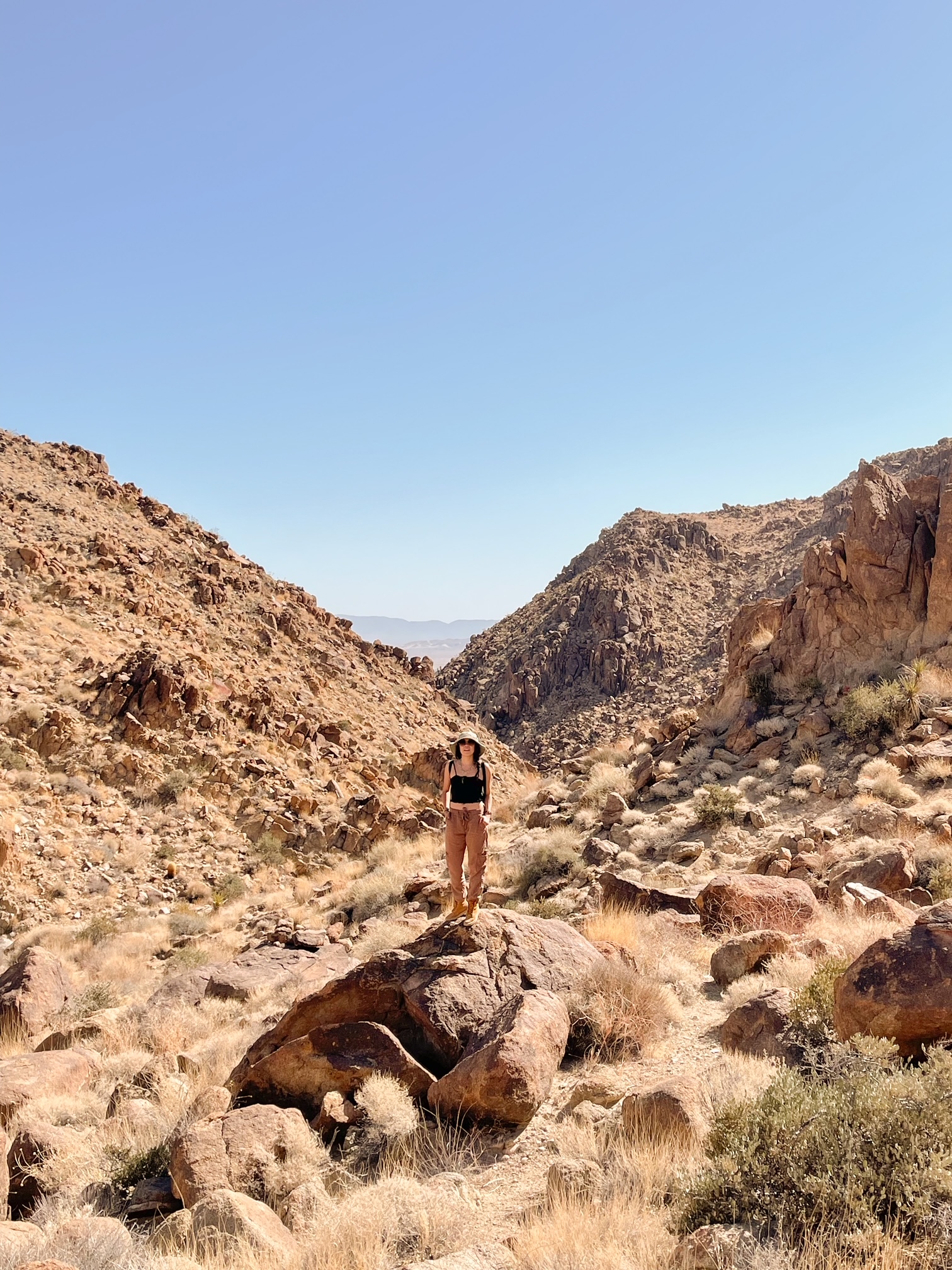

There was almost no shade along the trail (at least, not until we reached the oasis), so I was glad that we started the hike at around 7:00am. I knew the hike was famous for it’s grove of palm trees, but I was not expecting there to be so many towering palms surrounding a small watering hole. Definitely a rewarding site to see after a steep uphill climb, and a perfect place for a mid-morning or afternoon snack in the shade.
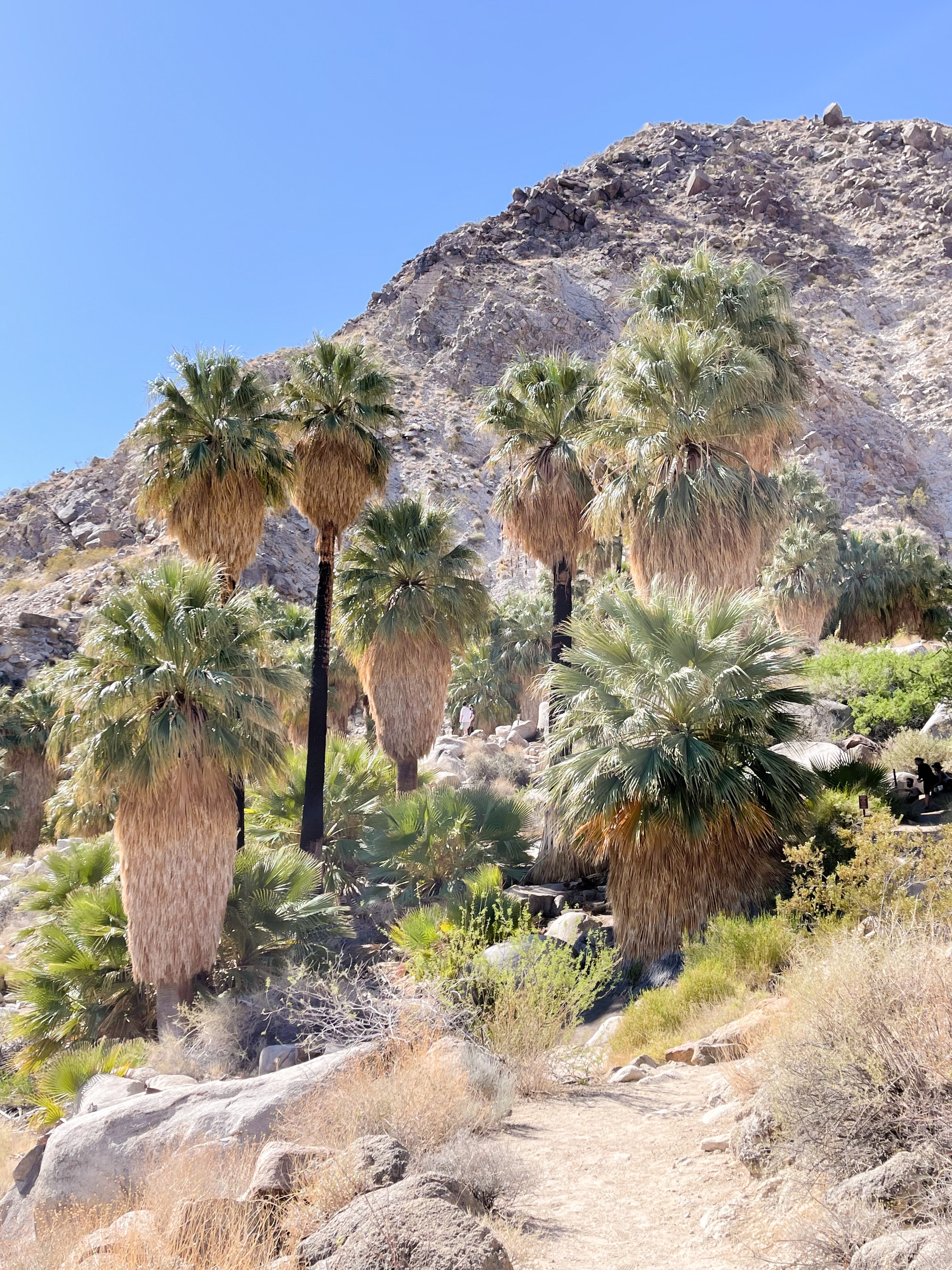
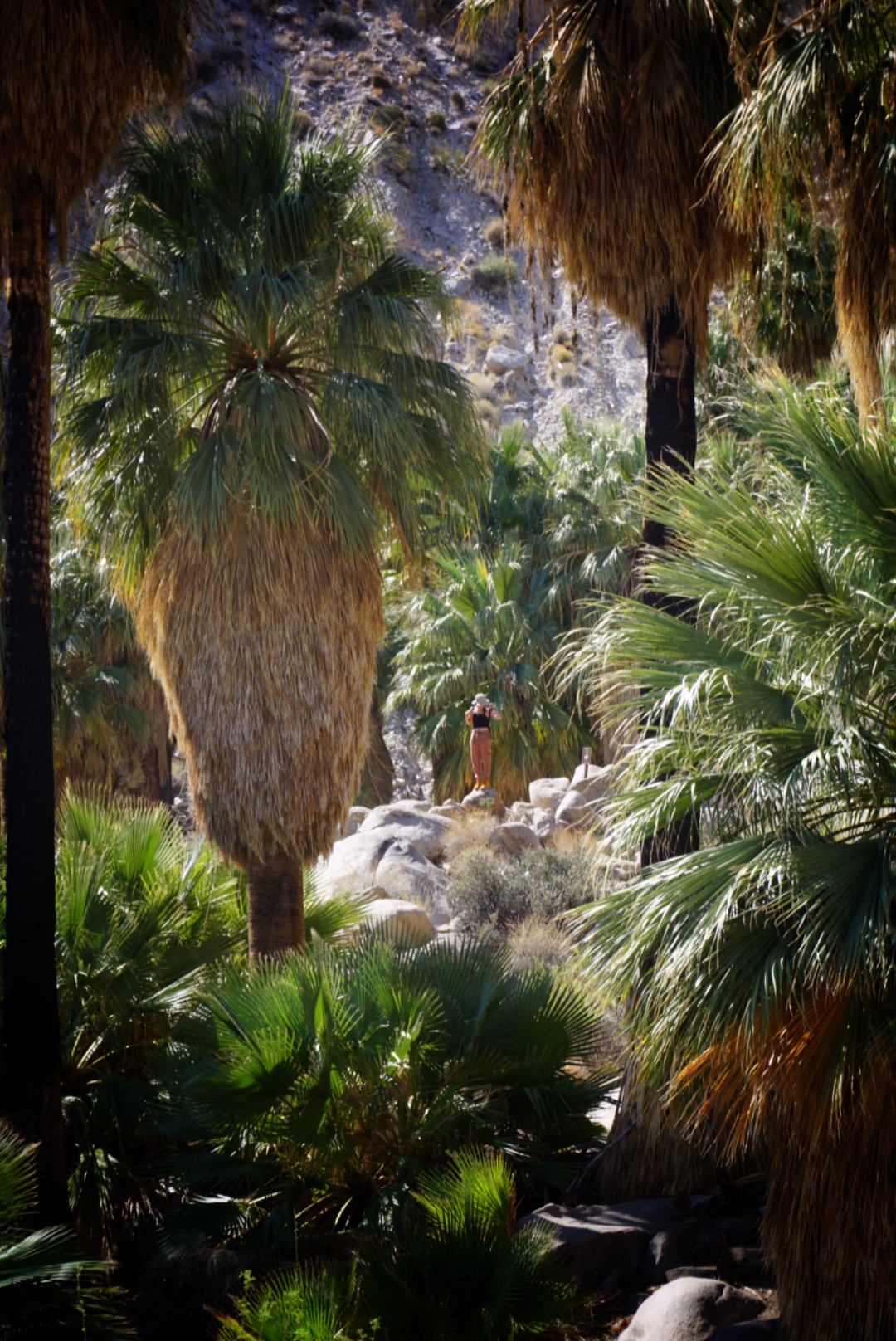
TIP: There is a parking lot designated just for Fortynine Palms Oasis Trail hikers. There’s also a restroom at the trailhead.
Lunch at La Copine
After our tiring hike, we re-energized ourselves with a wonderful lunch at La Copine. La Copine is just as quirky as the area surrounding it – from a distance, it looks like a lonely diner on a dusty dirt road, but the restaurant serves beautifully fresh produce, refreshing cocktails (get the Iced Palmer or the Desert Lily!), and French/L.A. inspired food. Even though we arrived right when they opened, we still had to wait around 30 minutes for a table so….go early if you can!
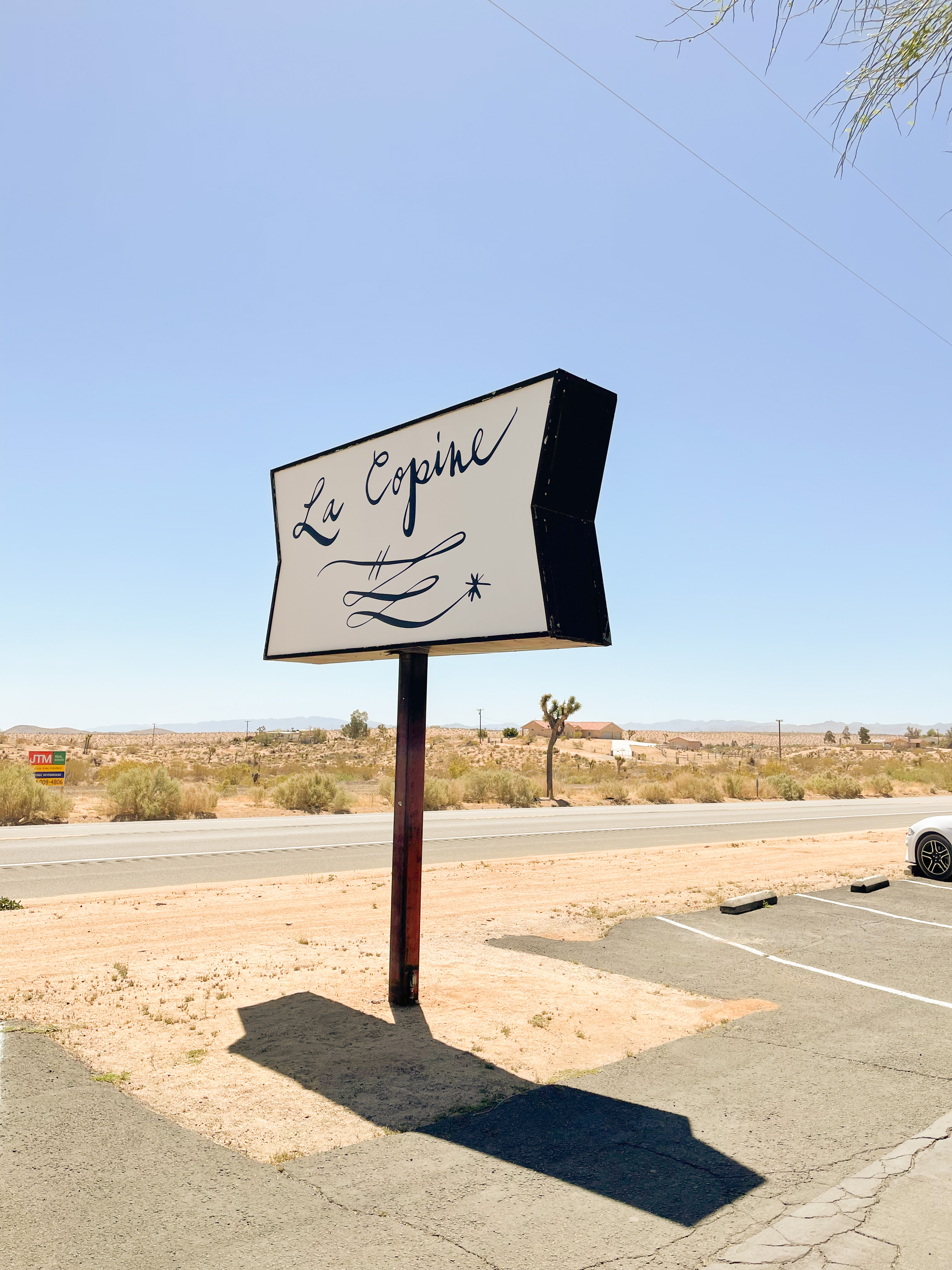
Joshua Tree Village
After lunch, we headed to the eccentric desert town of Joshua Tree Village. This ‘downtown’ area is really small, but it’s worth an afternoon stroll…especially on a Saturday afternoon when the weekly Farmer’s Market is in session! If you can’t get into La Copine, there are also several great dining options in Joshua Tree Village including a hearty brunch at Crossroads Café, organic vegan foods at Natural Sisters Café, or family and dog-friendly pub eats at the Joshua Tree Saloon.
Exploring Joshua Tree Village feels like traveling back-in-time. Our first destination was the Art Gallery and ‘World Famous Crochet Museum’, which is a free open-air museum that showcases paintings and a huge collection of crochet animals in a vintage Fotomat booth. Word on the street is that the Crochet Museum started when the artist (Shari Elf aka the Art Queen) received a crocheted dog as a silly gift from a friend.
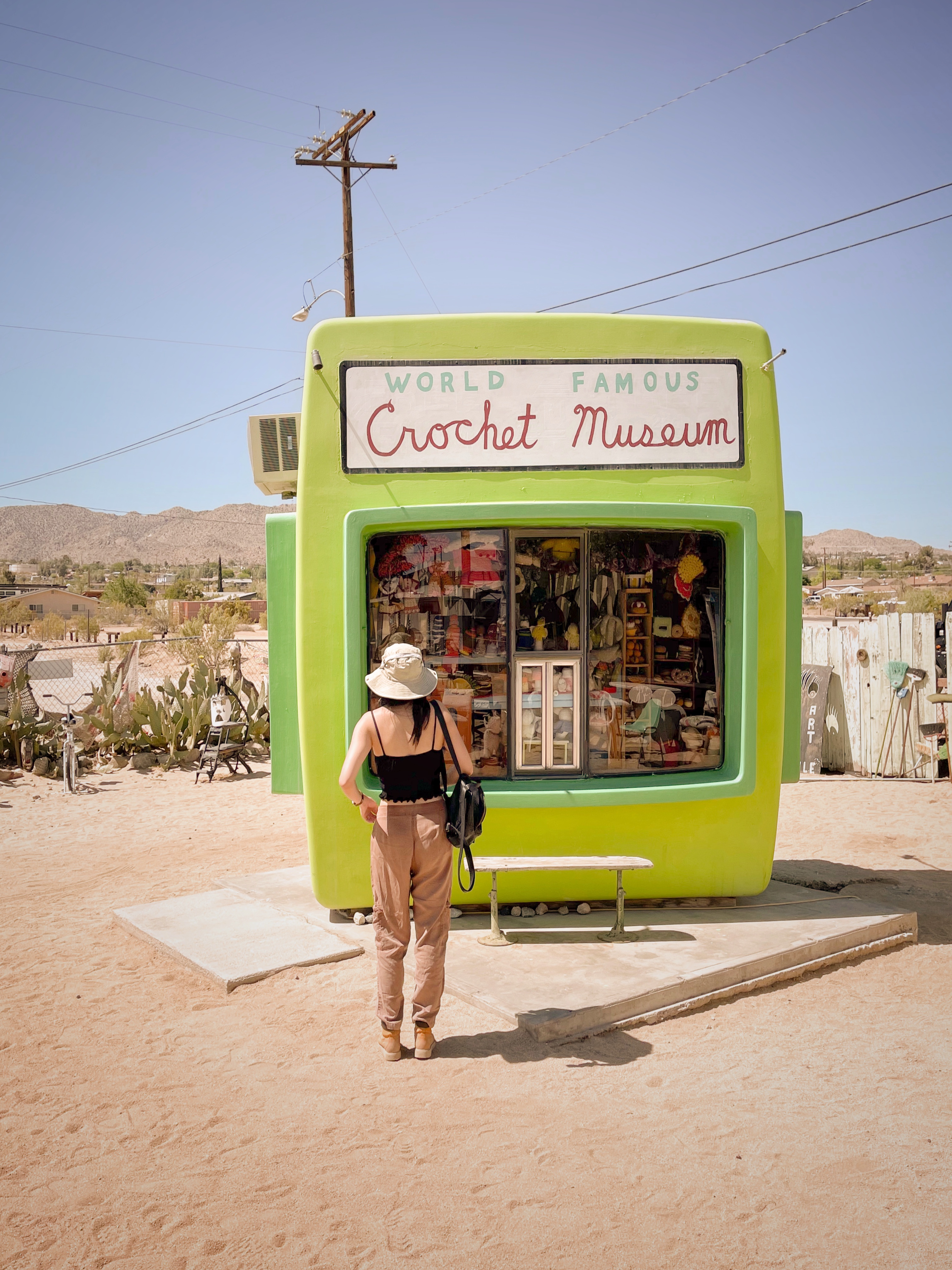
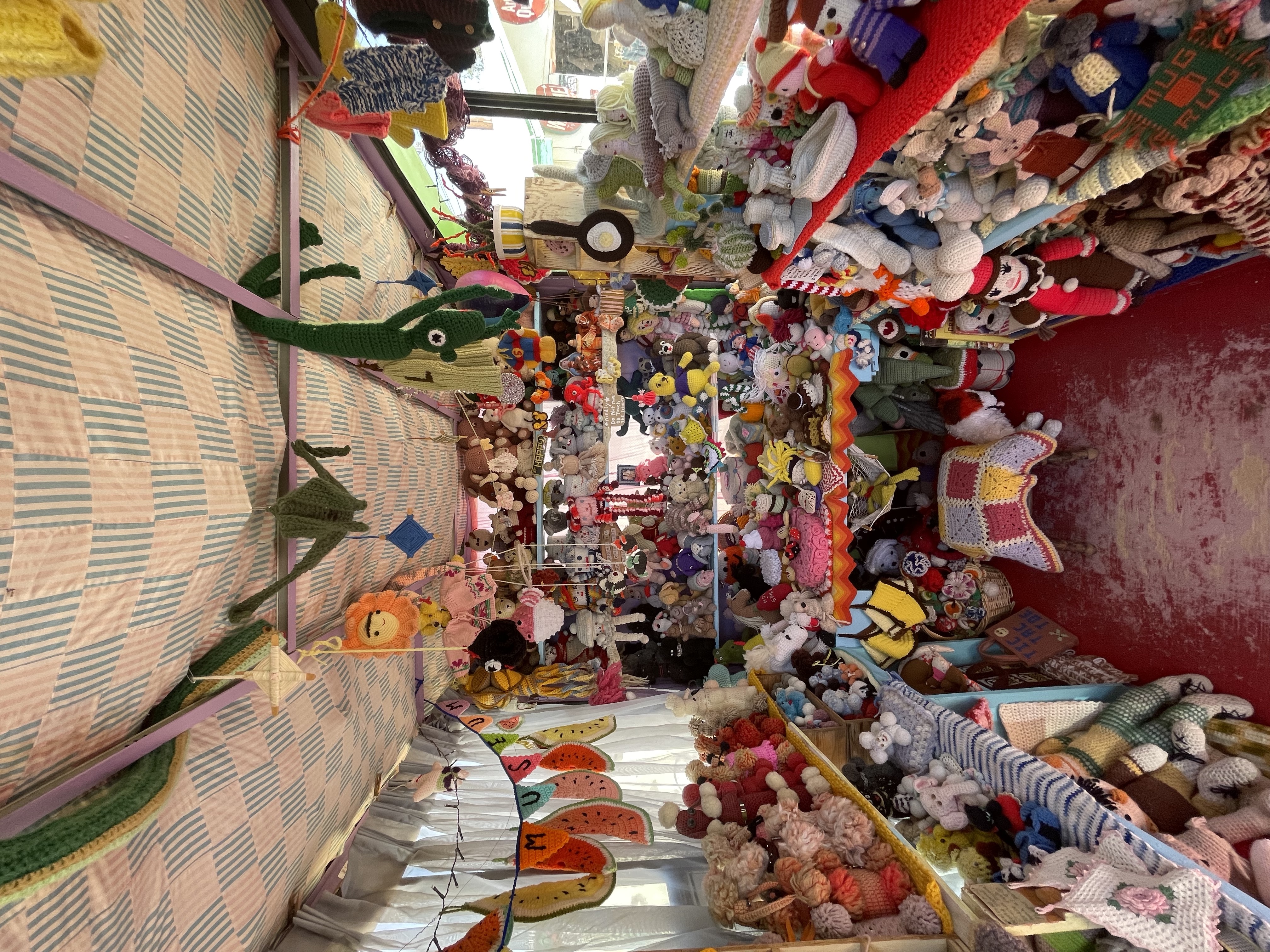
We got a kick out of the Beauty Bubble Salon and Museum, which featured vintage salon chairs and pastel trailers.
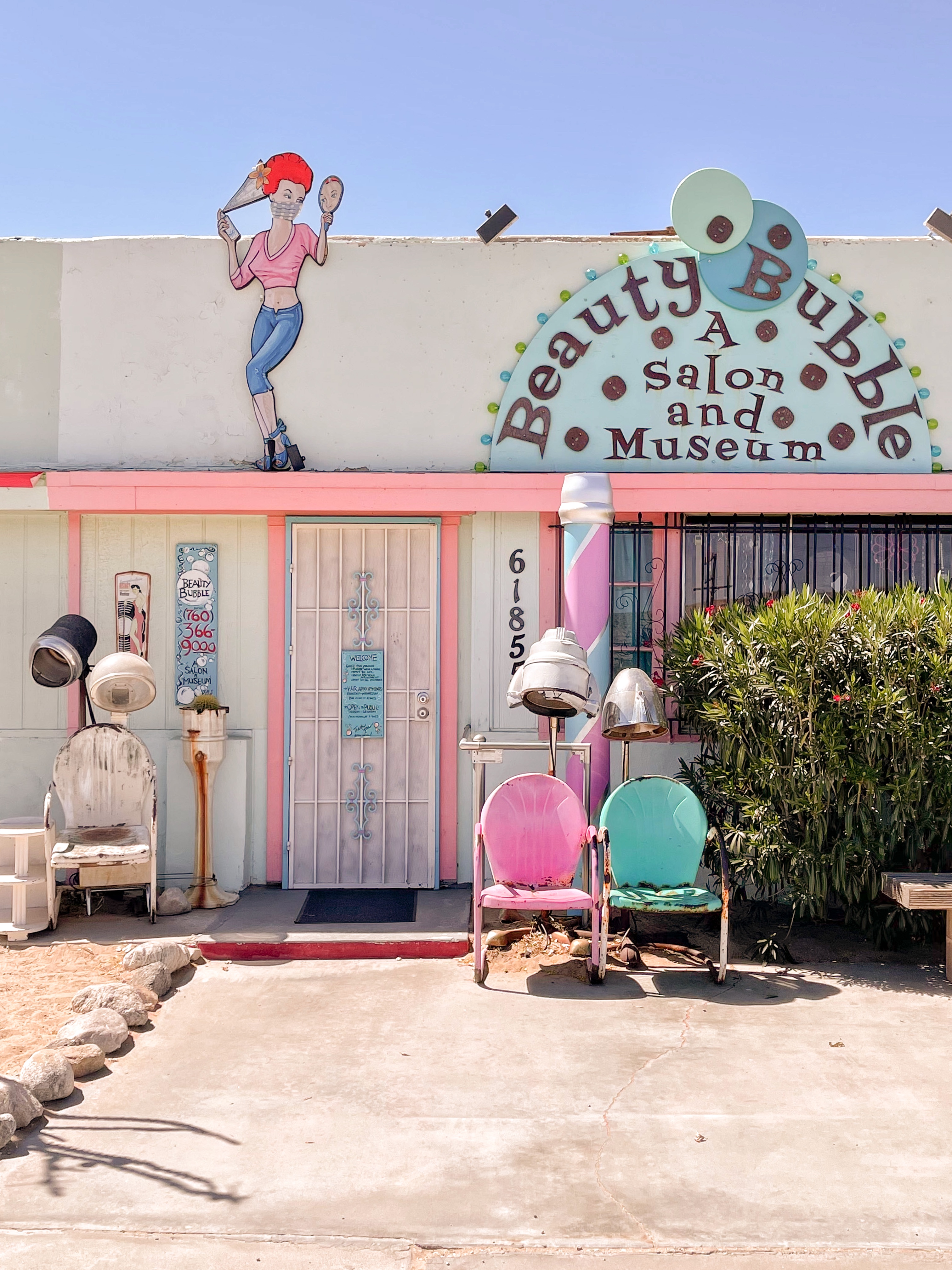
After picking-up a few local souvenirs from the Coyote Corner gift shop, we enjoyed strolling through the local farmer’s market which featured a ton of local farmers and artists. While at the farmer’s market, we ended up picking up a few fresh salads, baked goods, wine, and fruit to have for dinner at our AirBnB.

Relaxation and Stargazing
The rest of our day was spent relaxing and enjoying the sunset and a casual dinner at our AirBnB. Although there are a ton of things to see in the area, I highly recommend budgeting similar relaxation time in your own itinerary – it was so nice to have ‘nothing’ to do other than sit, enjoy wine on the porch, and enjoy some peace.
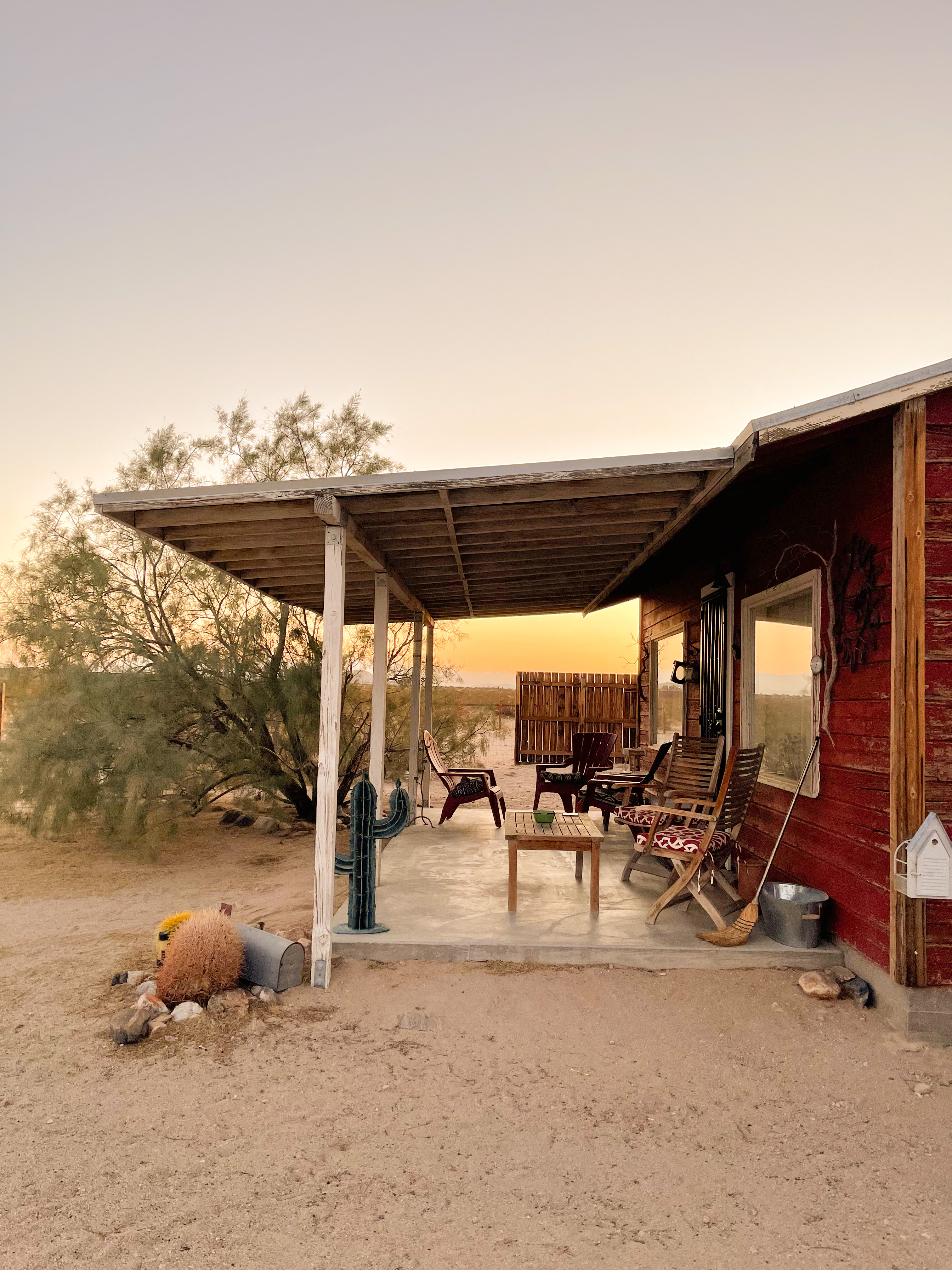

Because the park is located in the High Desert (5000 feet above sea level) and far away from the light pollution of major cities, Joshua Tree is one of the best places for stargazing in the U.S.. We turned off all the lights in our cabin and sat outside surrounded by the pitch-black of the desert for an hour or so…and it was a truly special experience. I’ve never seen so many stars in my entire life.
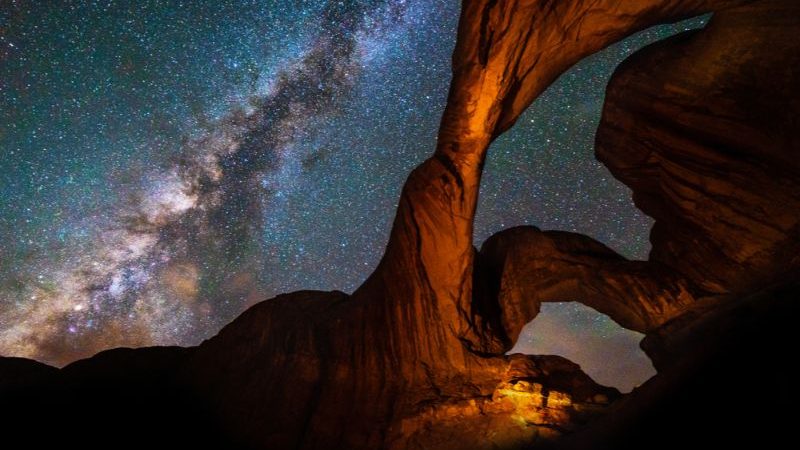
Day 2 Itinerary: Main Attractions of Joshua Tree
Our second day in Joshua Tree National Park was focused on what most would consider as the ‘main attractions’ of the park – in other words, the most touristy, busy, but must-visit spots (especially for first-time visitors!). The day started off as a lazy morning, where we enjoyed some brewed coffee from local Joshua Tree Coffee Company, and some baked good that we had picked up from the Farmer’s Market the day prior.
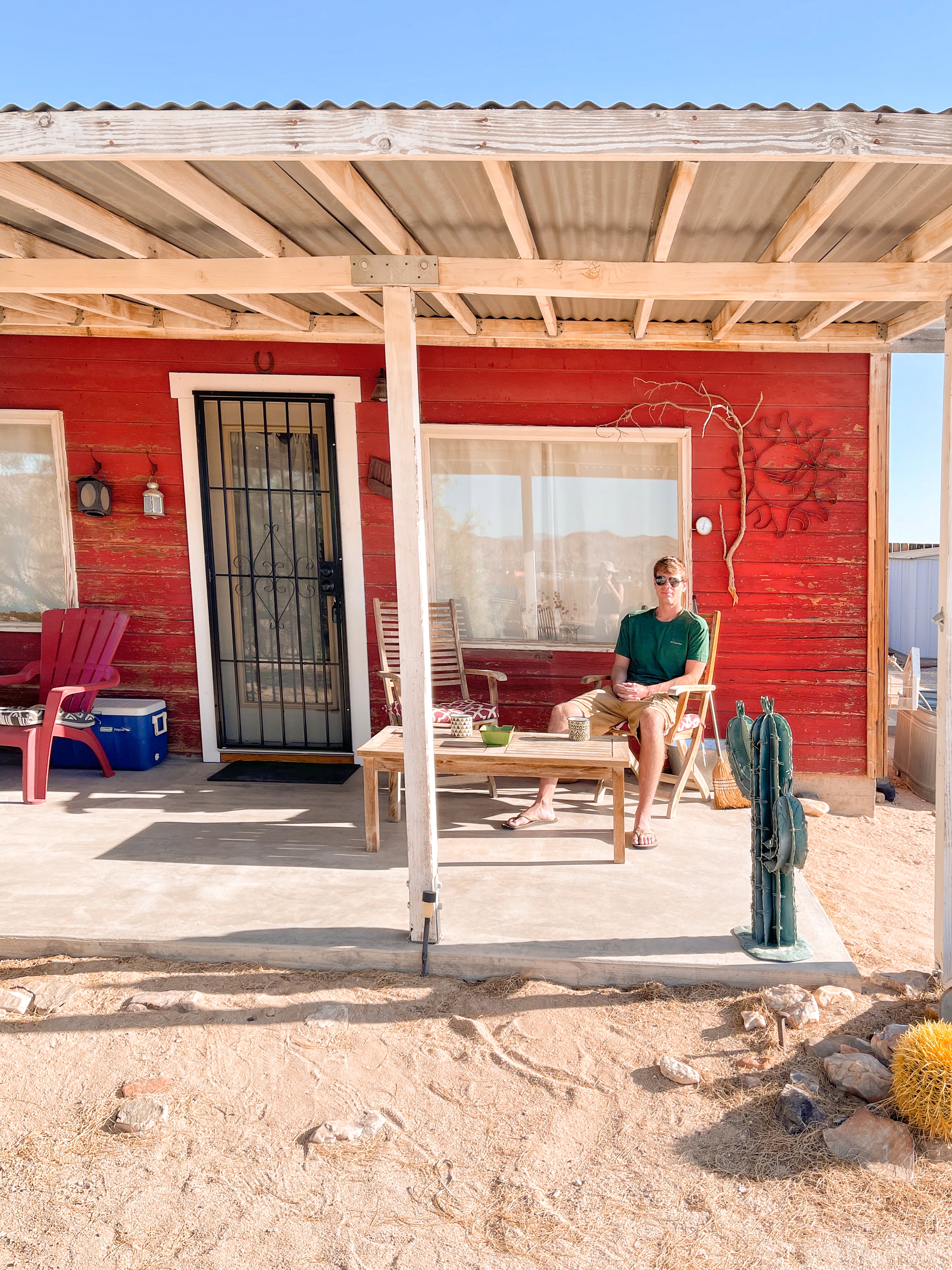

Arch Rock
Stop 1 had us completing the Arch Rock Nature Trail, which is an easy 1.2 mile heavily trafficked trail near the White Tank Campground. This hike was super fun – we especially enjoyed scrambling around the various rock crevices and boulders in the area (although I’ll admit, this did lead us off the ‘main path’, and so it took us some time for us to get back-on-track and actually find Arch Rock).
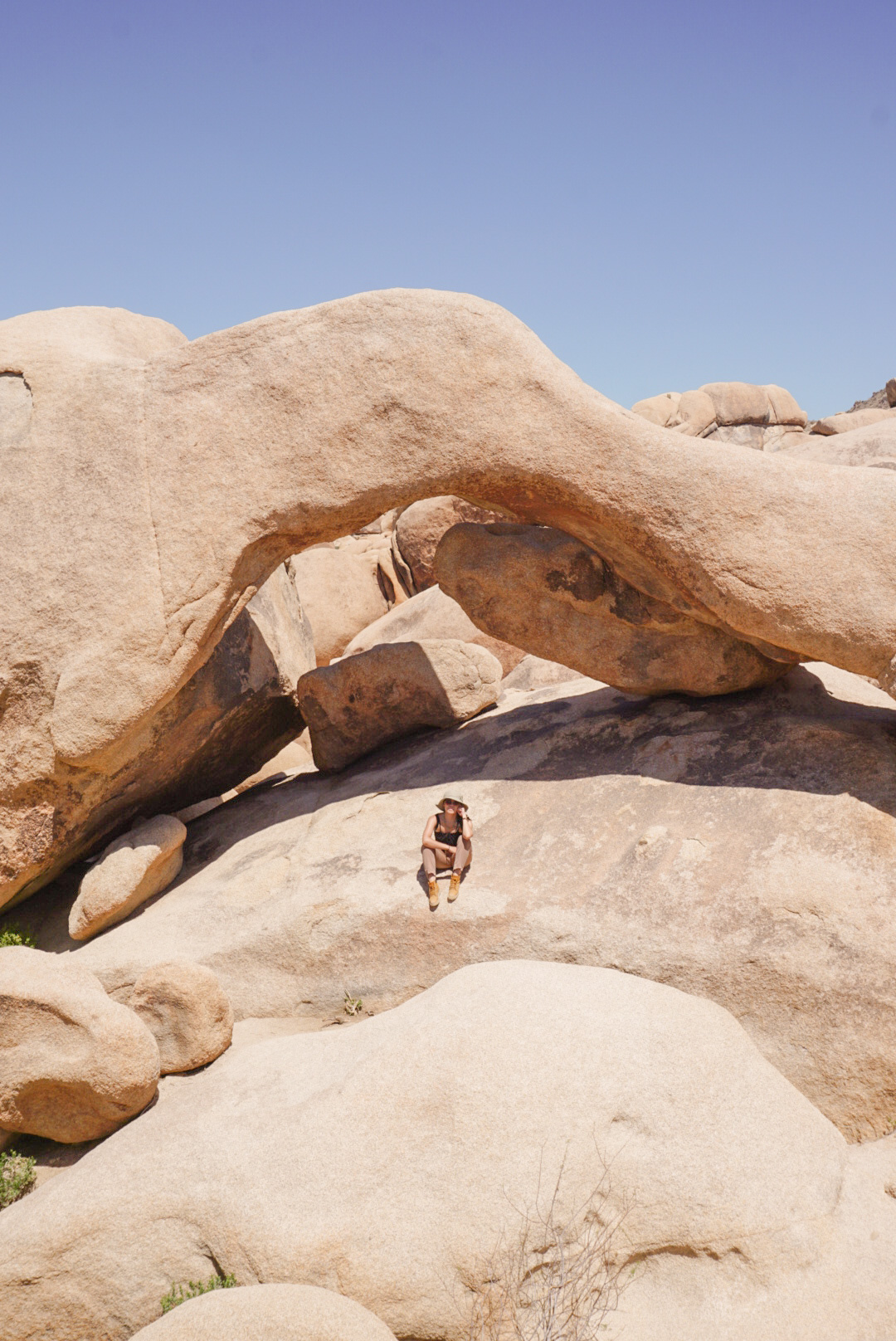
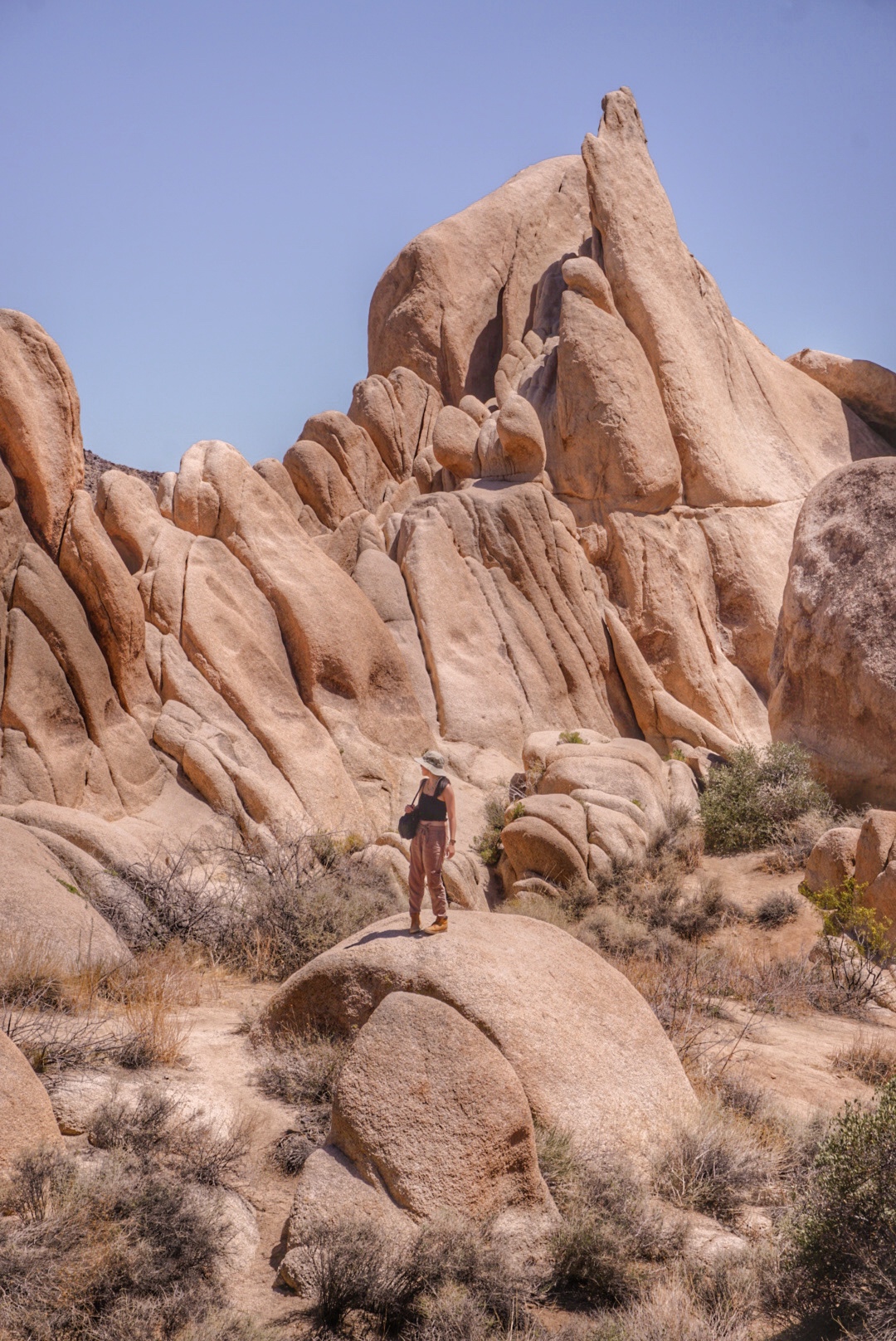
Skull Rock
From there, we visited Skull Rock which is a hollowed-out stone structure that resembles a skull. There are multiple options for visiting Skull Rock – you can either drive and park across the road to see the skull, or if you’re looking for a mini hike, you can get there via a 1.7 mile nature trail that is right across the entrance from the Jumbo Rocks campground.
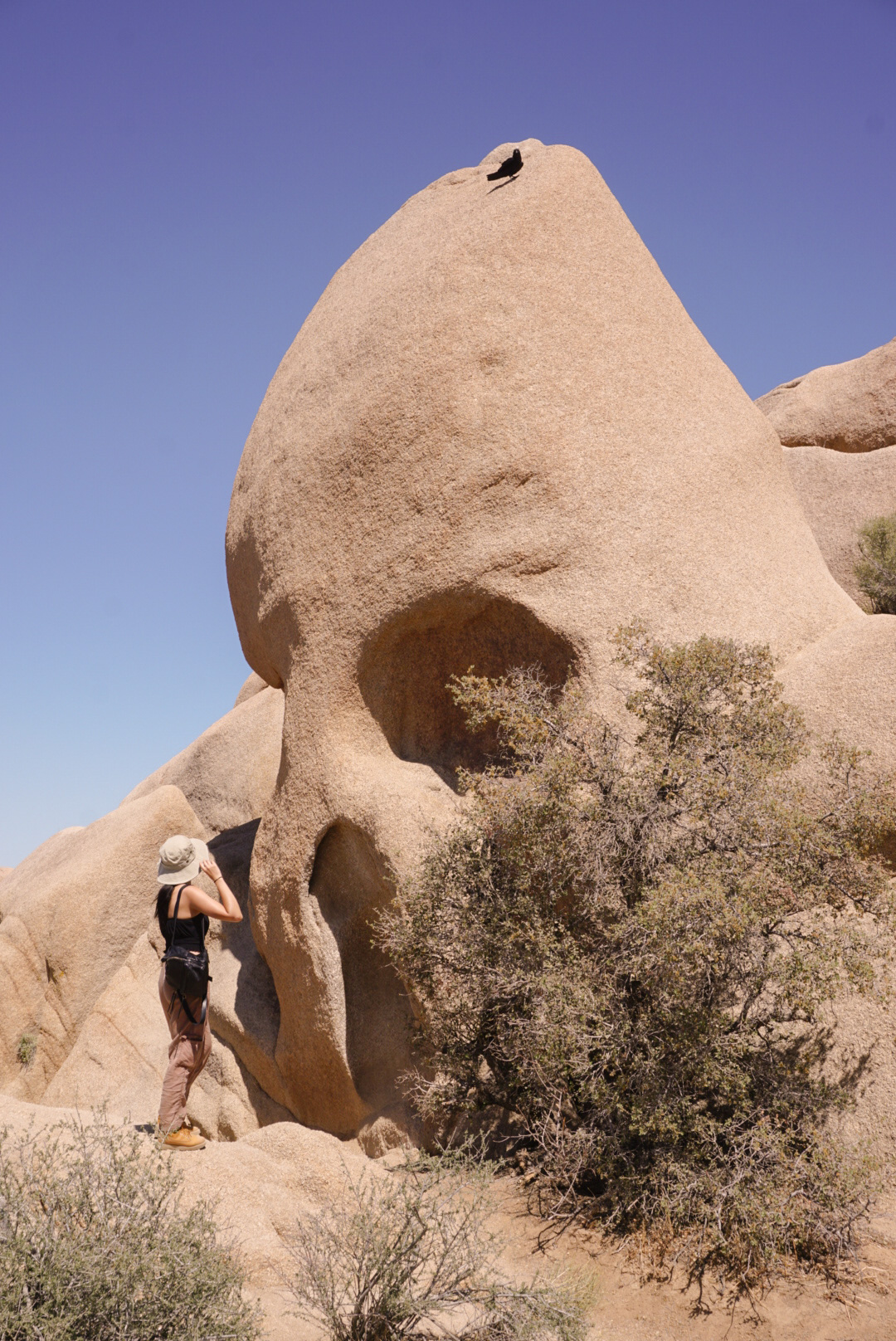
Cholla Cactus Garden
Our third stop of the day had us walking the Cholla Cactus Garden Nature Trail, which is a flat 0.33 mile nature trail. It’s worth spending time reading through the different education sign posts to learn more about what makes the cholla cactus so unique. The trail is beautiful any time of the day, but I would highly recommend visiting during golden hour (i.e., closer to sunset) when the sunset makes a beautiful backlight and the cacti really glow. It makes for a truly iconic ‘Joshua Tree’ photo shot!

TIP: Where closed-toe shoes and try to stay away from the cholla cactus. While the cacti look fuzzy (they’re also known as Teddy Bear Cactus or jumping cactus), they are extremely sharp and painful to touch.
Pioneertown
We ended the day by exploring Pioneertown, which is a quirky Old West town that started out as a 1940’s movie set. As the golden age of ‘wild wild west’ movies dwindled, the town pivoted to becoming more of a tourist site. Now, you can visit a number of retail stores located on Mane Street including a Pottery Shop, a Soap Shop, a Leather Shop, and multiple General Mercantile stores. You can also stay in Pioneertown – either at the local motel or at the camp sites available at the Pioneertown Corrals (first come, first serve).

After goofing off and taking lots of fun photos at Pioneertown, we enjoyed a hearty barbeque dinner at Pappy and Harriet’s. Pappy and Harriet’s is a definite must-visit – the food is delicious, the beer is cold, and the saloon-style restaurant also features live music multiple times a week.


Day 3 Itinerary: Hidden Valley Nature and Lost Horse Mine
Hidden Valley Nature Trail
My favorite hike that we completed in our 3 days in Joshua Tree National Park was the Hidden Valley Nature Trail. This easy one-mile loop is an extremely popular hike, so go early if you want to make sure to get a parking spot nearby. It takes you through a valley where you can see all different types of unique rock formations and desert flora and fauna (we found some great panoramic views of Joshua trees here).
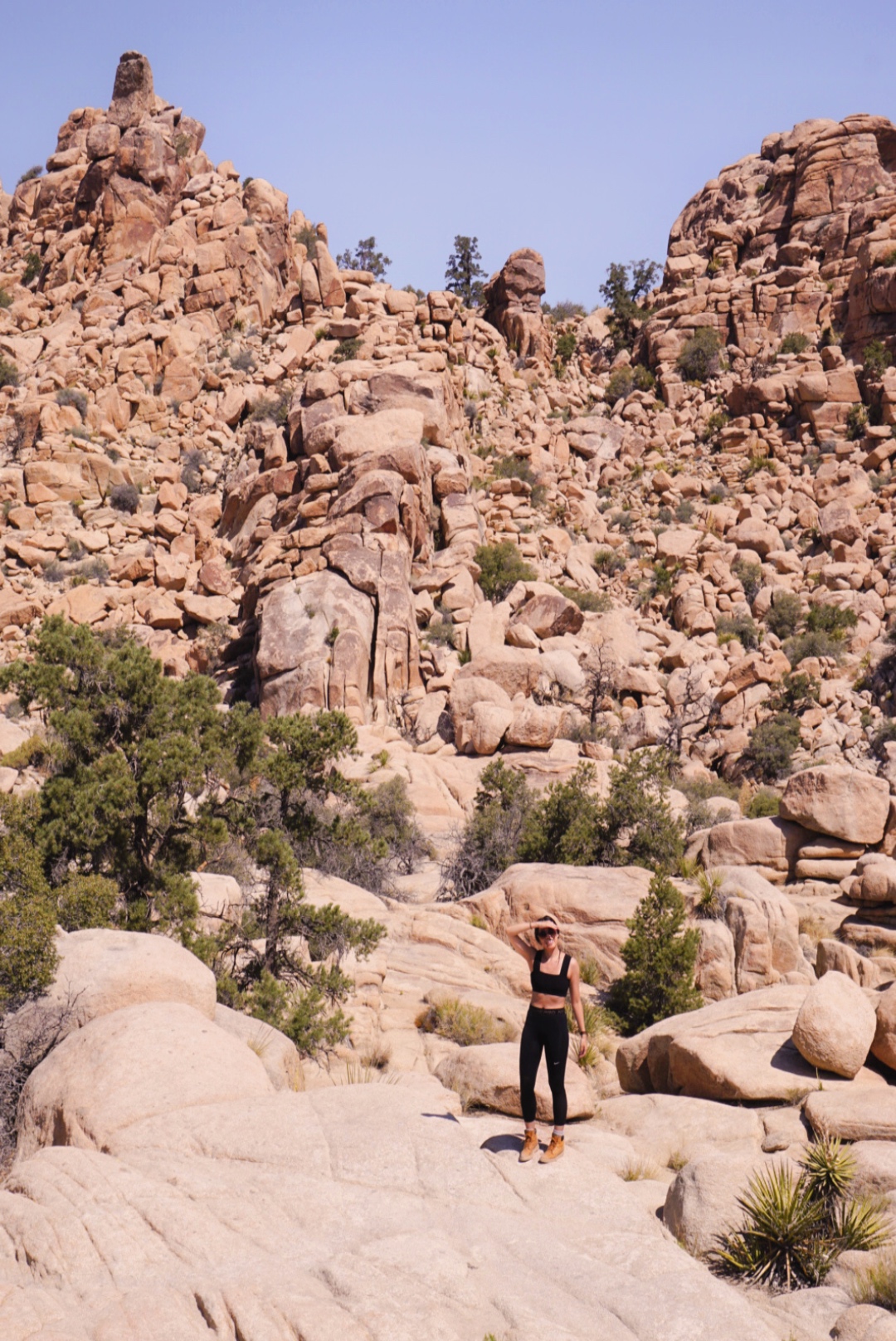
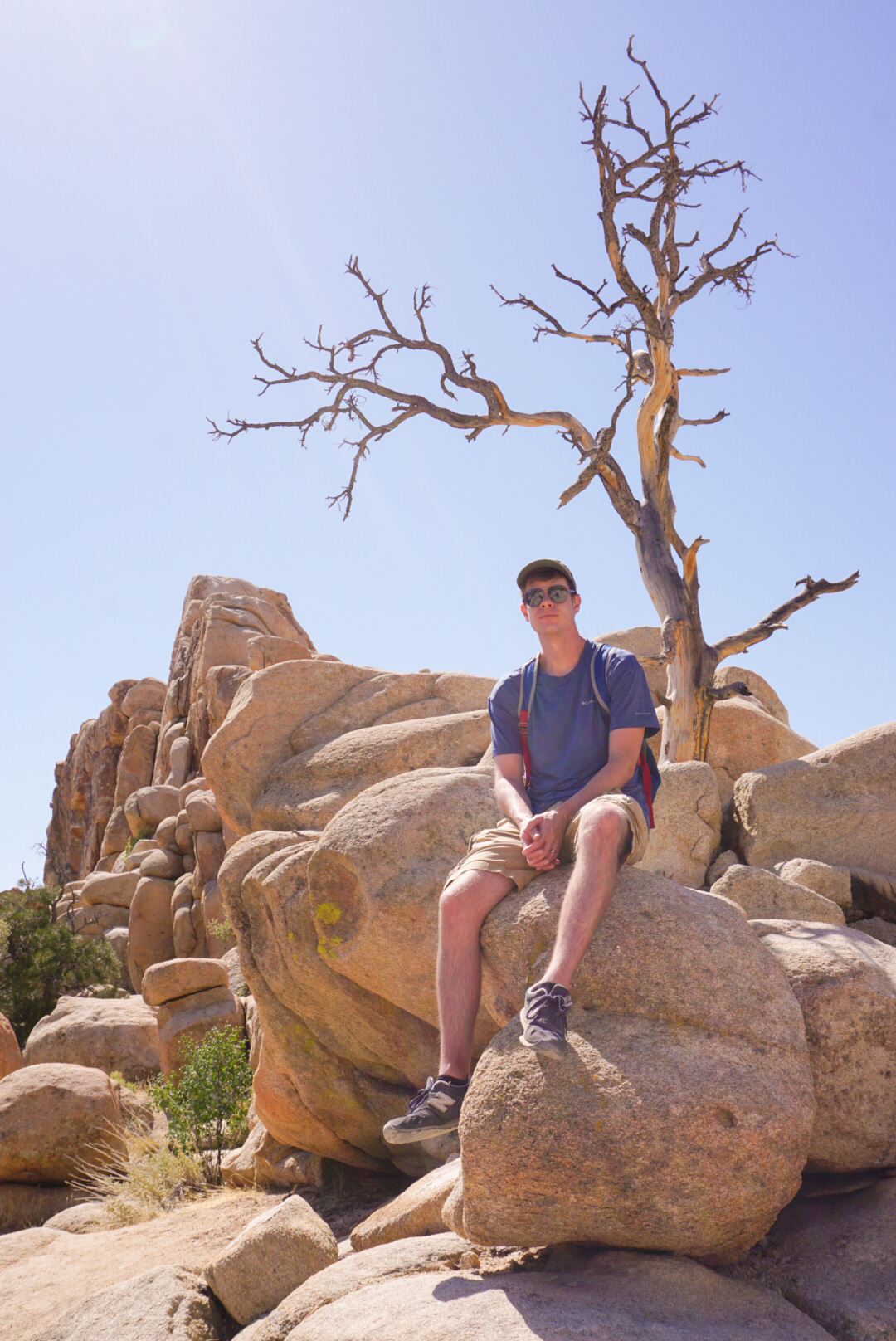
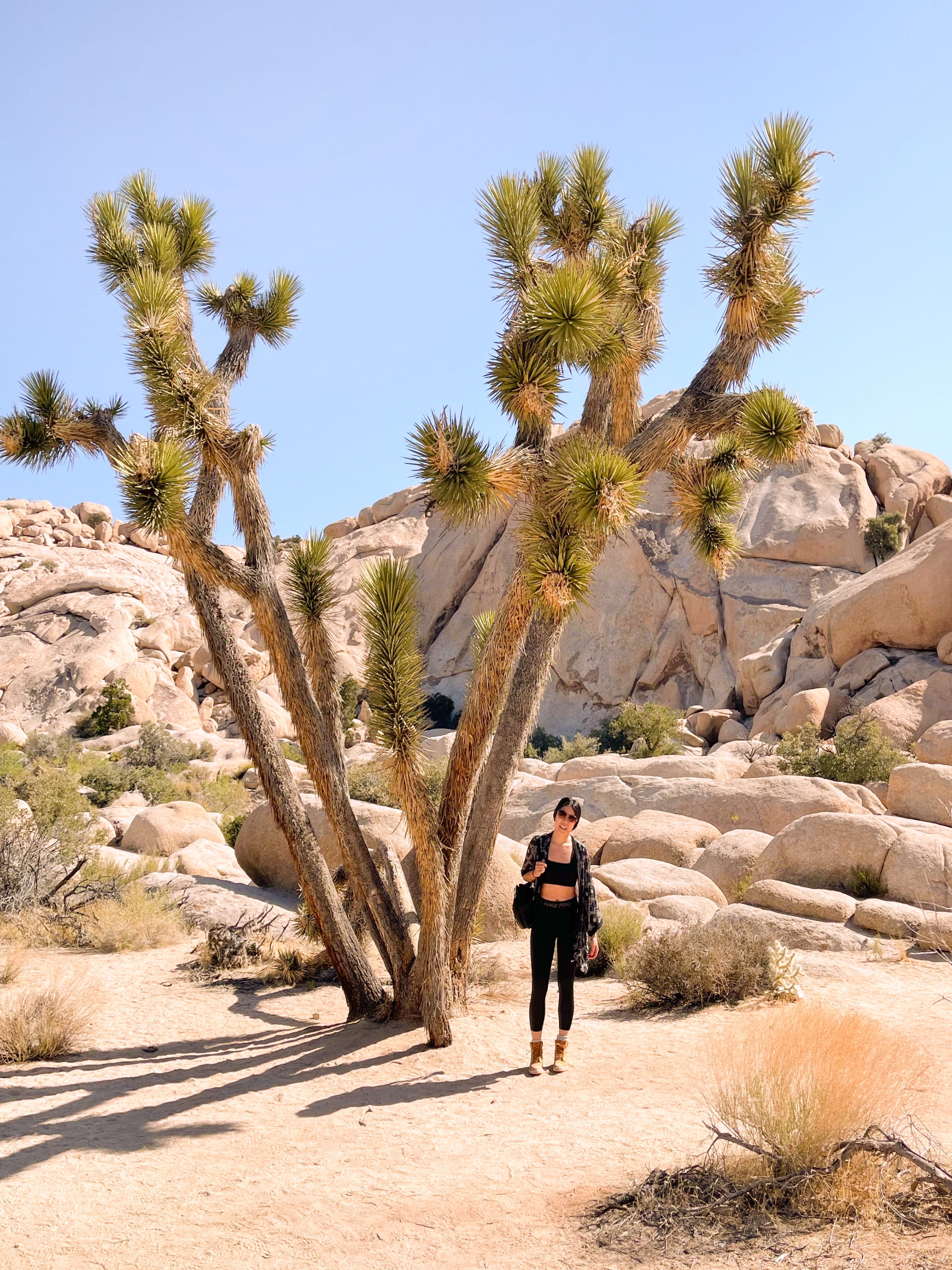
FUN FACT: Joshua Trees are referred to as the “great canteen of the desert”. They can grow up to 70 feet tall, live up to 150 years, and store moisture in their roots that local animals can use to relieve their thirst.
Lost Horse Mine Loop Trail
We then proceeded to hike the moderate Lost Horse Mine Trail, which is a unique 4-mile trail through expansive desert to a 100+ year old gold mine. Although the trail wasn’t super difficult, it took us several hours to complete…and was also made more brutal due to the afternoon heat. If you decide to hike this trail, make sure to bring a hat and lots of water – there’s little-to-no shade available on this trek!
The best part about the Lost Horse Mine Loop Trail was reaching the final destination – the actual Lost Horse Mine! This well-preserved mine was established in the 1890’s and produced over 10,000 ounces of gold and 16,000 ounces of silver during operation (that’s over $5 million dollars in today’s currency!). While you can’t go inside the mine itself (several of the wooden portions have collapsed and there are nearby sink holes that make the site itself very dangerous), you can peek through the surrounding gates to get a glimpse of the historical structure.

Keys View
Keys View is the highest point within Joshua Tree National Park, and on a clear day, provides sweeping panoramic views of the Coachella Valley. It’s one of the most accessible viewpoints in Joshua Tree – no hiking required, you can just drive up to the parking lot near the viewpoint. It’s a great destination to start or end your day with, because of the wonderful sunrise and sunset views.
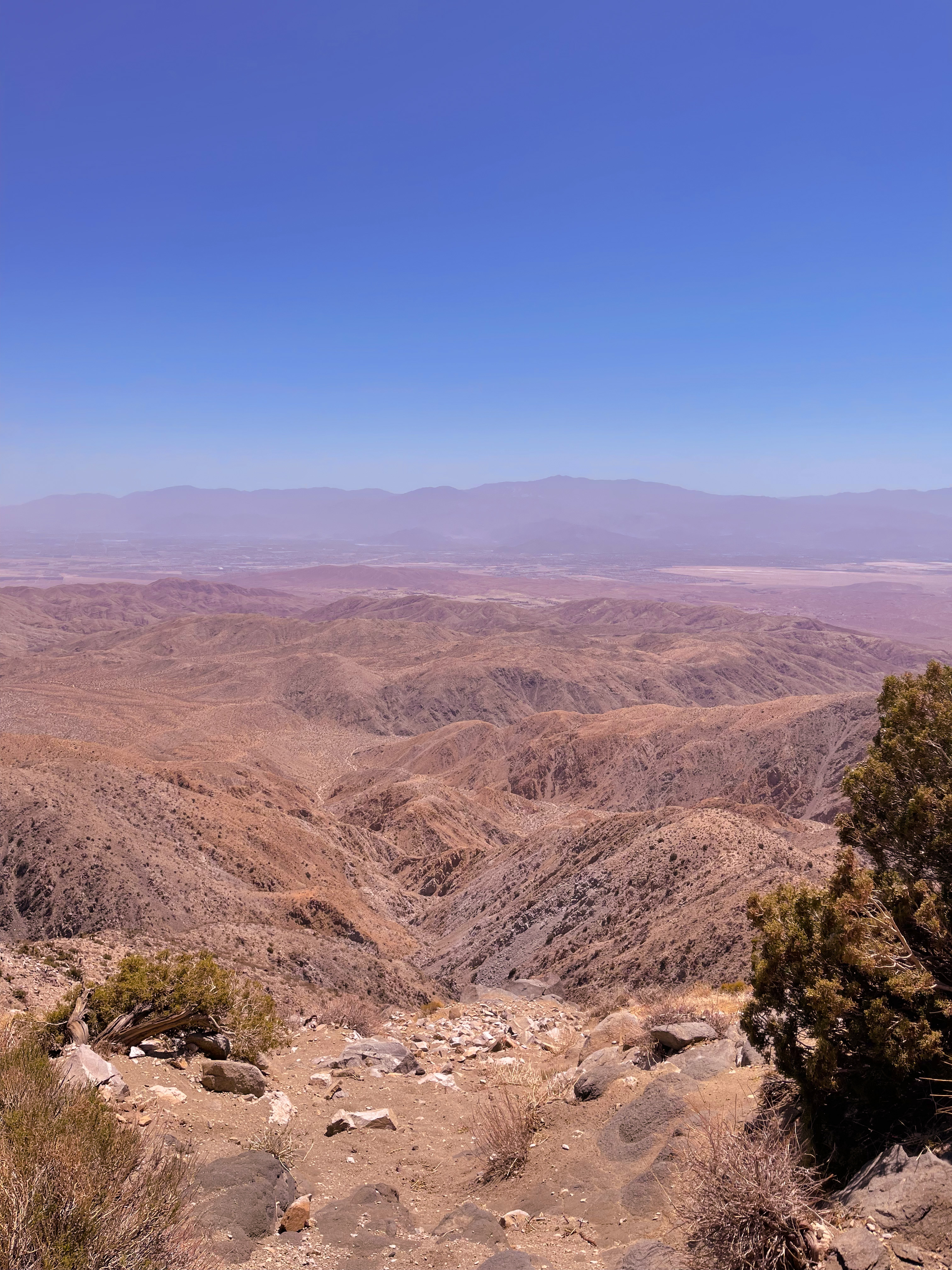
And there you have it – the exact itinerary we followed when spending 3 days in Joshua Tree National Park! Leave a comment below if you have any questions or thoughts, and happy planning!
Related Post: Palm Springs Weekend Itinerary Inspiration
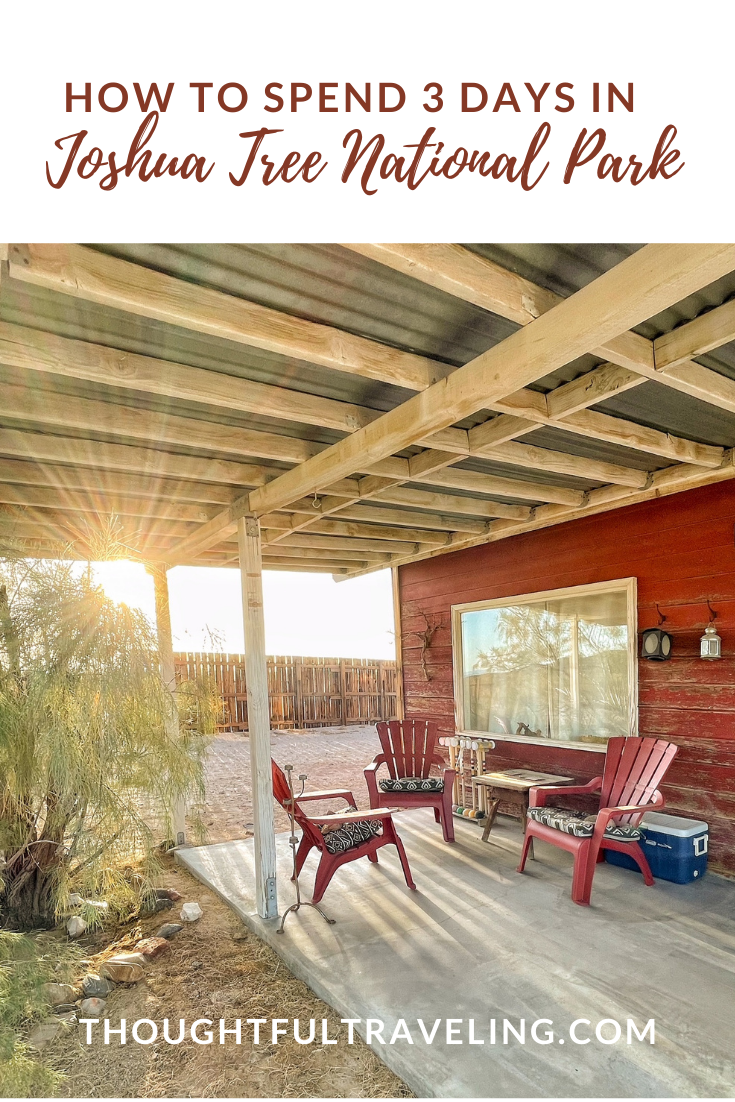
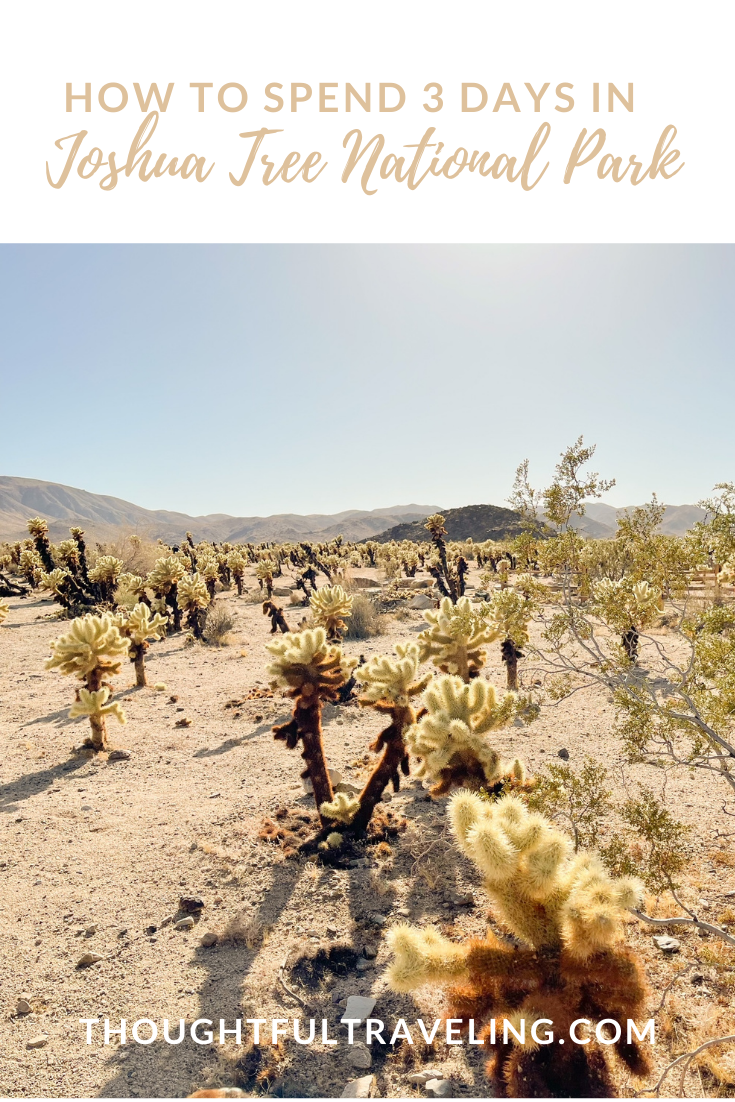

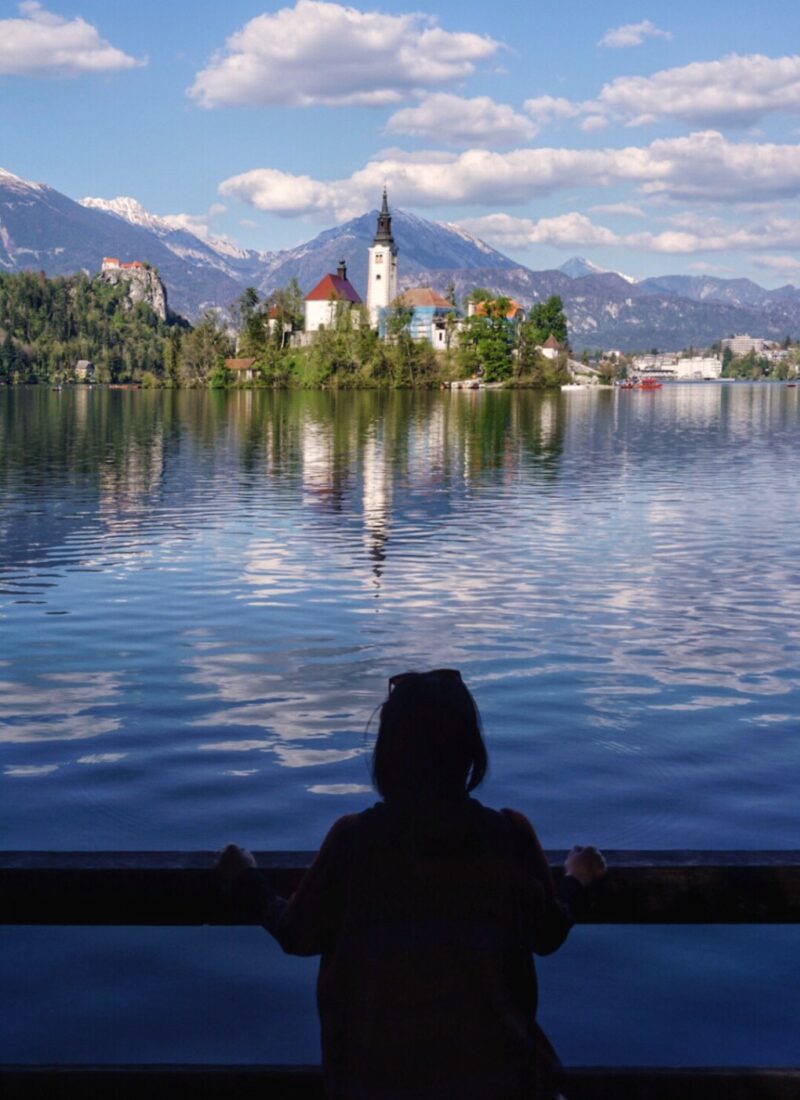


Leave a Reply